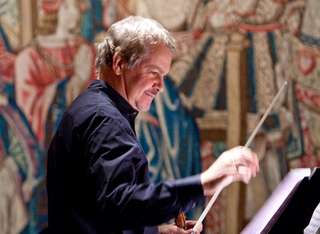|
Back
The Spiritual Is Willing New York
Rubin Museum of Art
04/25/2010 -
Reflections: A Pilgrim’s Progress. Presented in association with Music Without Borders
Heinrich Franz Biber: Mystery Sonatas (Text by Carl Sagan from Billions and Billions, Cosmos and The Varieties of Scientific Experience)
Francis Poulenc: Sonata for Violin and Piano (Text by Federico García Lorca from Libro de Poemas)
Bruce Saylor: Dante’s Suite (Text by Dante Alighieri from The Divine Comedy: Inferno)
Gil Morgenstern (Artistic Director and Violin), Donald Berman (Piano), Bill Camp (Narrator)

G. Morgenstern (© SnapHappy Photos, LLC)
The Rubin Museum of Art is dedicated to one country, Tibet. But its three floors at 150 West 17th Street contain a treasure house of modern and ancient Tibetan art and esoterica. Many mandalas, statues of gods and demons, contemporary paintings by Tibetan artists, a bookshop with the usual trove of guides to Tibet (and Bhutan) and the usual spiritual guides Eastern style.
I had been there several times, but didn’t know that the Museum also has an elegant little concert hall/theatre on the bottom floor. It probably fits around 250 people, but the stage is adequate, the acoustics (from this first concert I heard) were excellent, without any undue resonance, and this program, highlighted by that splendid violinist Gil Morgenstern, was more than imaginative.
None of the three composers had any specific association with Tibet, but each was made to have an association with a dedicated text which skirted upon the spiritual. The works chosen were hardly religious in the usual sense of the word. Then again, Tibetan Buddhism is hardly orthodox, from the positive-negative angle Judeo-Christian-Islamic traditions either. From the highest meditation to the most horrific demonology, from a fire-burning hell to the acceptance by all Tibetans that every single grain, yak, atom, human, tree and rock is part of universal holiness, Tibet’s world is a nirvana of possibilities.
Thus, Gil Morgenstern and Donald Berman could begin with a fiercely Catholic work by the esteemed 17th Century Austrian composer-violinist Heinrich Biber. His 15 “Mystery” sonatas were tiny suites on the events during the Life of Jesus, but if one didn’t know the titles of the half-dozen played here–The Annunciation, The Nativity, Presentation of Jesus in the Temple, Agony in the Garden, The Ascension and The Descent of the Holy Spirit–they would have sounded like early Baroque movements for violin and keyboard. (Including even a “Jig” for the descent of the Holy Spirit).
Not amongst the six was “The Crucifixion” itself, for the torture of a god baffles and bewilders Buddhists of all stripes. (The Buddha himself died peacefully under a Bo Tree.) Just as well, for Mr. Morgenstern was a wizard with this music, which must have been almost unplayable in the late 17th Century.
The text was spoken by Bill Camp, a well-known actor around New York, with devoted expression. Here, between each short movement, we had lines from Carl Sagan, a man who appreciated the spirituality of science itself. They dealt with that old saw about the watchmaker, as well as the age of the universe, and the wonder of man. Biber might not have understood it in Catholic Vienna, but the audience here reveled in it.
Mr. Morgenstern and pianist Donald Berman launched into the Poulenc Violin Sonata with hardly a pause, and the violinist obviously felt more at home here. The first movement is far more violent than most of Poulenc’s music. But before the “slow, calm intermezzo”, Mr. Camp read a poem about death, by Federico García Lorca in English.
It was touching, never sentimental, and merged well with Poulenc’s solemn music. Personally, I had a bone to pick with the personalities. Francis Poulenc, while not a collaborator, never left Paris during the German Occupation, and probably tried to ignore it. Federico García Lorca, not only sympathized with the Left against the Falangists, but was purposely brually murdered by Franco’s thugs
The final work was the second this month based on Dante’s Divine Comedy. Louis Andriessen’s full opera was a fierce loud production. Bruce Saylor was writing for solo violin, and it was less a piece itself than a accompaniment to the words.
Mr. Morgenstern worked the tremolos, trills, downward waves on his instrument, while Mr. Camp read various verses from Dante’s work. One hears few great works with narration and music together. Prokofiev’s rare Eugene Onegin and Berlioz’s Lélio are amongst the best. Mr. Saylor’s work did have an effect, but admittedly Dante’s poetry was even more evocative.
Two addendas. Three more concerts will be held at the Rubin Museum this year. The Shanghai Quartet on May 3, the Eroica Trio on May 16 and Orchestra of St. Luke’s with Peter Lieberson’s King Gesar on November 20 and 21st.
Hopefully the same photographic exhibition will be on this floor adjacent to the theatre. Tom Wool spent about a month in a remote valley of Tibet, and his black-and-white photographs are graphic, intimate, and magnificent pictures of these singularly wonderful people.
Harry Rolnick
|